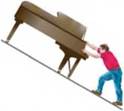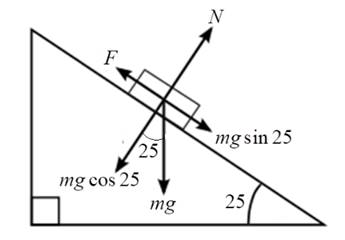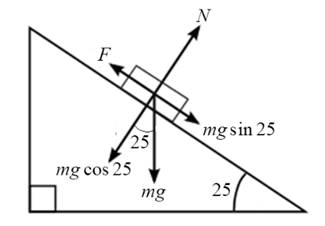
Concept explainers
A 380-kg piano slides 2.9 m down a 25° incline and is kept from accelerating by a man who is pushing back on it parallel to the incline (Fig. 6-36). Determine: (a) the force exerted by the man, (b) the work done on the piano by the man, (c) the work done on the piano by the force of gravity, and (d) the net work done on the piano. Ignore friction.

Figure 6-36
Part (a)
The force exerted by the man.
Answer to Problem 10P
Solution:1574 N
Explanation of Solution
Given:
A 380-kg piano slides 2.9 m down a
Formula used:
By Newton’s second law of motion:
Where, m is the mass and a is the acceleration.
Calculation:
The various forces acting on the piano are shown in the figure.

The piano does not slide if applied force is
Conclusion:The force exerted by the man is 1574 N.
Part(b)
The work done on the piano by the man.
Answer to Problem 10P
Solution:The work done on the piano by the man is
Explanation of Solution
Given:A 380-kg piano slides 2.9 m down a
Formula used:
The work done on the piano by the man can be obtained by:
Where, F is the applied force and d is the displacement.
Calculation:
The work done on the piano by the man,
Conclusion:The work done on the piano by the man is
Part (c)
The work done on the piano by the force of gravity.
Answer to Problem 10P
Solution:The work done on the piano by the force of gravity is
Explanation of Solution
Given:A 380-kg piano slides 2.9 m down a
Formula used:
The work done on the piano by force of gravity can be obtained by:
Where, F is the applied force and d is the displacement.
Calculation:
The work done on the piano by the force of gravity is
Conclusion:The work done on the piano by the force of gravity is
Part (d)
The net workdone on the piano.
Answer to Problem 10P
Solution:The net work done on the piano is zero.
Explanation of Solution
The various forces acting on the piano are shown in the figure.

Given:A 380-kg piano slides 2.9 m down a
Formula used:
The work done on the piano by force of gravity can be obtained by:
Where, F is the applied force and d is the displacement.
Calculation:
Since the net displacement of the piano is zero, the net work done on the piano is zero.
Conclusion:Thenet work done on the piano is zero.
Chapter 6 Solutions
Physics: Principles with Applications
Additional Science Textbook Solutions
Campbell Essential Biology with Physiology (5th Edition)
Organic Chemistry (8th Edition)
Chemistry (7th Edition)
Campbell Biology (11th Edition)
Chemistry: Structure and Properties (2nd Edition)
Campbell Biology in Focus (2nd Edition)
- 3arrow_forwardSet ба ||Axl 49.32 6b 71 Ay 22 Magnitude of A Angle of A 24.04 Angle of -A 22 54 155.96 ° (pos Ax) 204.04 ° (neg Ax) 335.96 ° (pos Ax) ° (neg Ax) 115.77 ° (pos Ax) 295.77 ° (pos Ax) -39 81 208.78 ° (neg Ax) 28.78 ° (neg Ax)arrow_forward3AA . not sure what i am getting wrongarrow_forward
 College PhysicsPhysicsISBN:9781305952300Author:Raymond A. Serway, Chris VuillePublisher:Cengage Learning
College PhysicsPhysicsISBN:9781305952300Author:Raymond A. Serway, Chris VuillePublisher:Cengage Learning University Physics (14th Edition)PhysicsISBN:9780133969290Author:Hugh D. Young, Roger A. FreedmanPublisher:PEARSON
University Physics (14th Edition)PhysicsISBN:9780133969290Author:Hugh D. Young, Roger A. FreedmanPublisher:PEARSON Introduction To Quantum MechanicsPhysicsISBN:9781107189638Author:Griffiths, David J., Schroeter, Darrell F.Publisher:Cambridge University Press
Introduction To Quantum MechanicsPhysicsISBN:9781107189638Author:Griffiths, David J., Schroeter, Darrell F.Publisher:Cambridge University Press Physics for Scientists and EngineersPhysicsISBN:9781337553278Author:Raymond A. Serway, John W. JewettPublisher:Cengage Learning
Physics for Scientists and EngineersPhysicsISBN:9781337553278Author:Raymond A. Serway, John W. JewettPublisher:Cengage Learning Lecture- Tutorials for Introductory AstronomyPhysicsISBN:9780321820464Author:Edward E. Prather, Tim P. Slater, Jeff P. Adams, Gina BrissendenPublisher:Addison-Wesley
Lecture- Tutorials for Introductory AstronomyPhysicsISBN:9780321820464Author:Edward E. Prather, Tim P. Slater, Jeff P. Adams, Gina BrissendenPublisher:Addison-Wesley College Physics: A Strategic Approach (4th Editio...PhysicsISBN:9780134609034Author:Randall D. Knight (Professor Emeritus), Brian Jones, Stuart FieldPublisher:PEARSON
College Physics: A Strategic Approach (4th Editio...PhysicsISBN:9780134609034Author:Randall D. Knight (Professor Emeritus), Brian Jones, Stuart FieldPublisher:PEARSON





